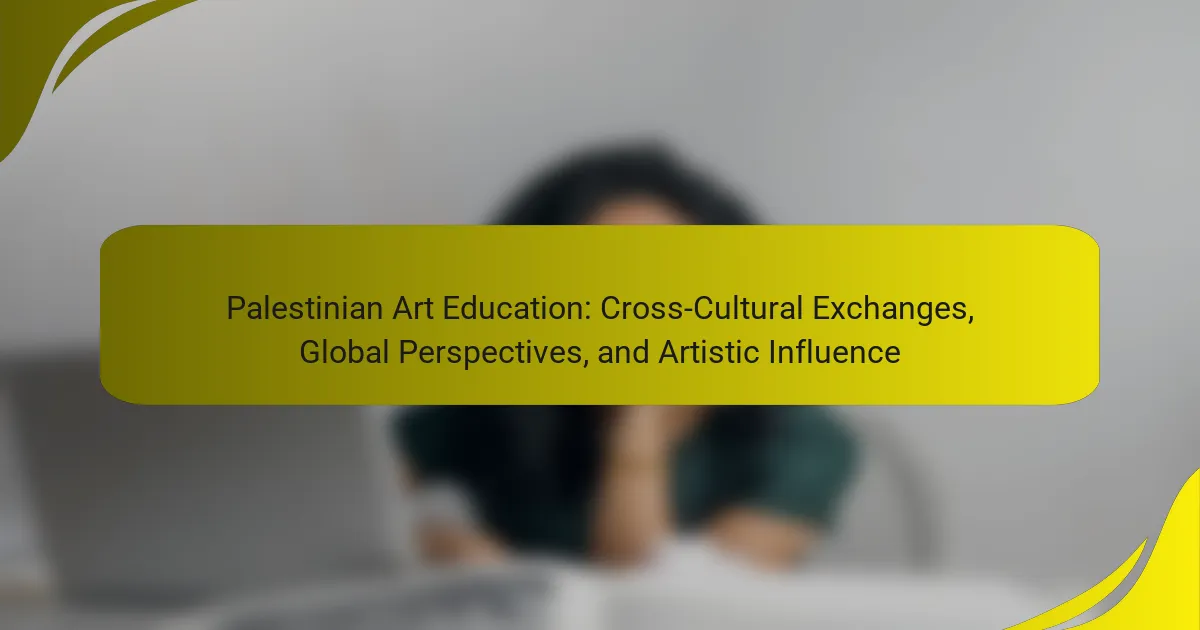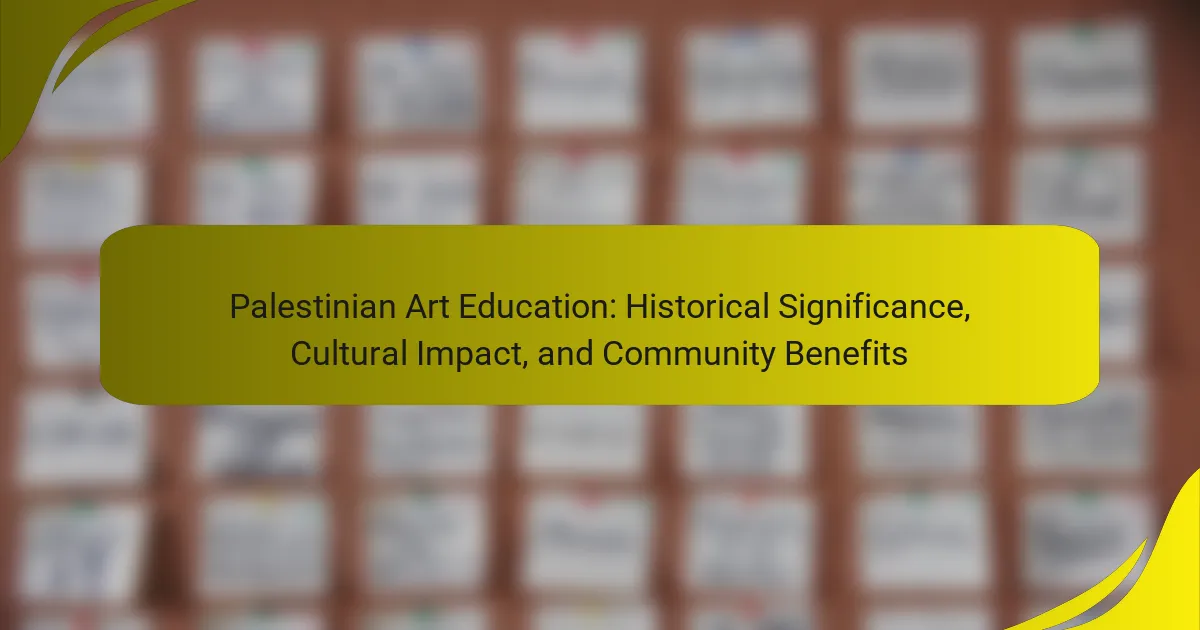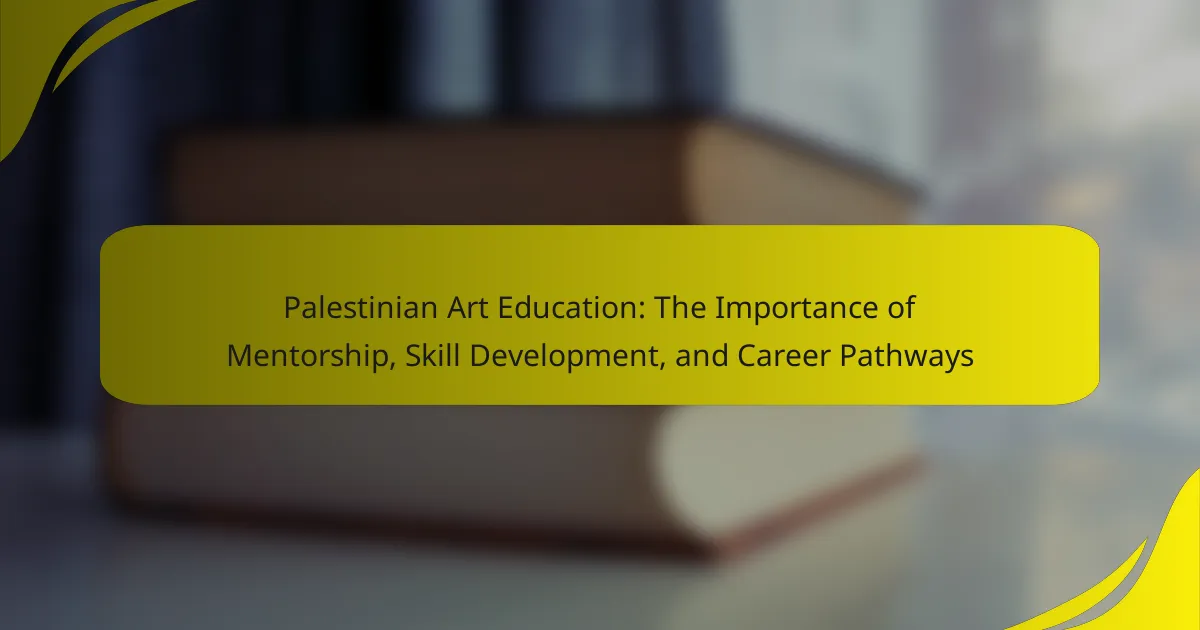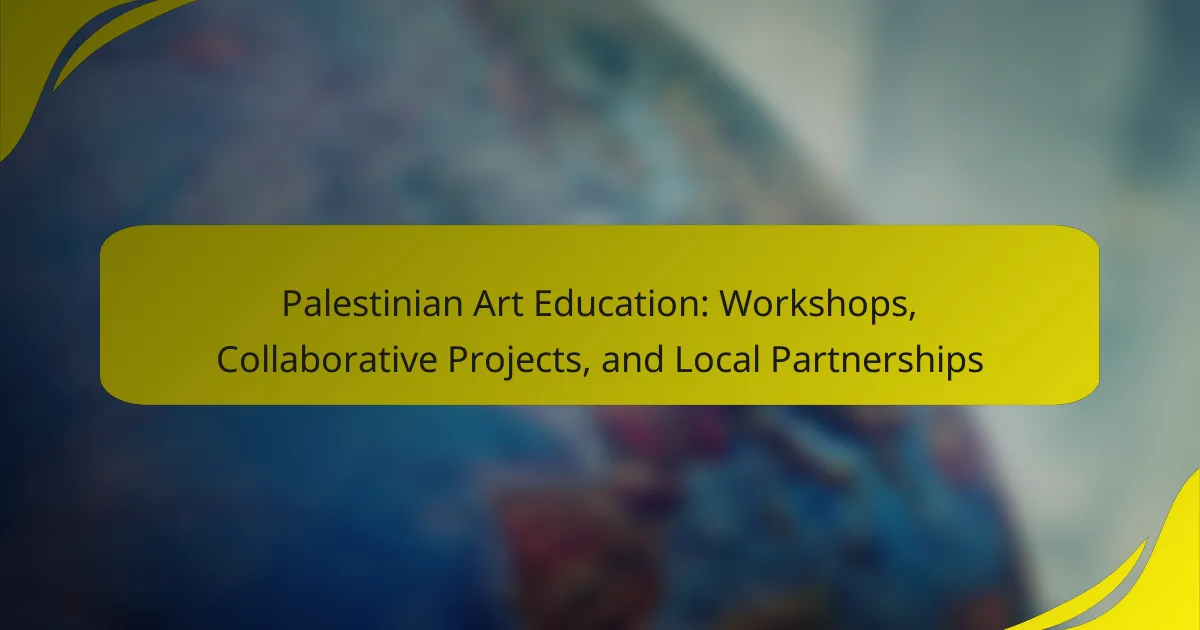Palestinian Art Education focuses on teaching and learning in the visual arts within the Palestinian territories, aiming to enhance artistic skills and cultural awareness among students. This education incorporates both traditional and contemporary Palestinian art forms, emphasizing creativity, critical thinking, and cultural identity. Key funding sources include governmental support, international NGOs, and private donations, while sustainability practices involve using recycled materials and promoting local resources. Resource allocation is managed through collaboration between the Palestinian Authority, NGOs, and community initiatives, ensuring the continuation and growth of art education despite financial challenges. The article explores these aspects in detail, highlighting the significance of art education in preserving Palestinian heritage and fostering community resilience.
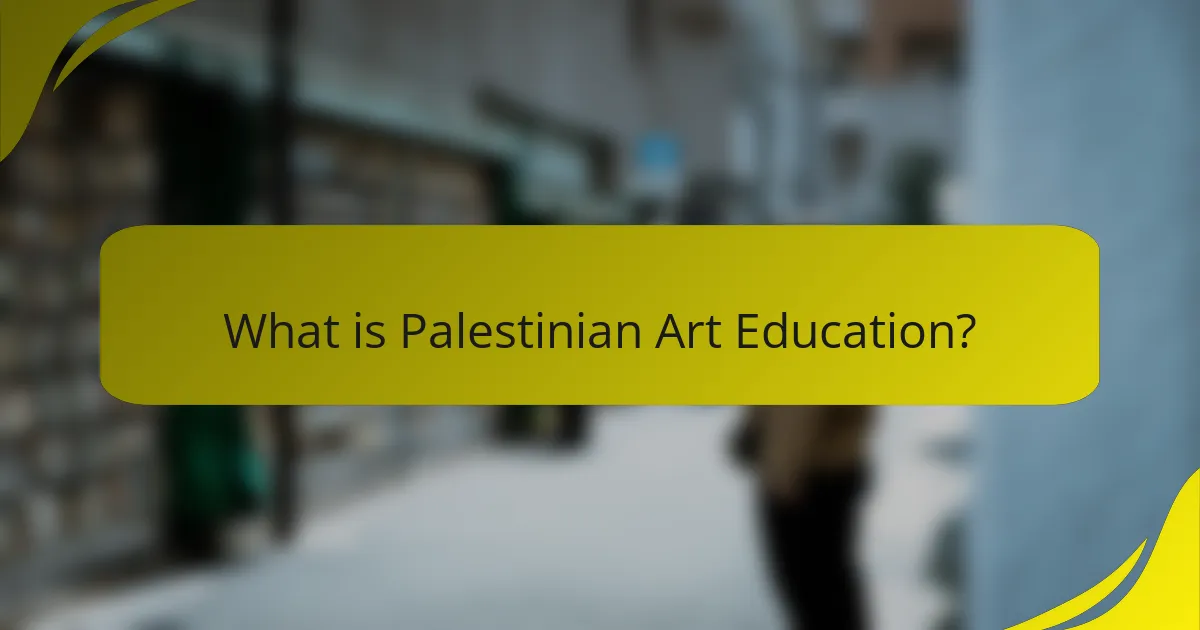
What is Palestinian Art Education?
Palestinian Art Education is a system of teaching and learning focused on the visual arts within the Palestinian territories. It aims to develop artistic skills and cultural awareness among students. This education often incorporates traditional and contemporary Palestinian art forms. Institutions offering this education include universities, community centers, and art schools. The curriculum typically emphasizes creativity, critical thinking, and cultural identity. Palestinian Art Education also seeks to address social issues through artistic expression. The importance of this education is underscored by its role in preserving and promoting Palestinian heritage. Research indicates that art education can enhance community resilience and foster a sense of identity among students.
How does Palestinian Art Education differ from other forms of education?
Palestinian Art Education differs from other forms of education primarily due to its cultural and political context. It integrates local history, identity, and resistance into its curriculum. This education often emphasizes artistic expression as a means of coping with conflict and occupation. Unlike traditional art education, it addresses themes of social justice and cultural heritage. Palestinian art educators frequently face resource limitations, impacting their teaching methods. They rely on community support and international collaborations for funding and materials. This environment fosters a unique resilience and creativity among students. The focus on community engagement distinguishes it from more conventional educational frameworks.
What are the historical influences on Palestinian Art Education?
Palestinian Art Education has been influenced by various historical factors. The Ottoman Empire’s rule introduced formal education structures, including art education. Following World War I, British mandate policies impacted cultural expression and education systems. The 1948 Nakba led to the displacement of many artists and educators, affecting art education. The establishment of the Palestine Liberation Organization in the 1960s emphasized cultural identity, promoting art as a form of resistance. The Oslo Accords in the 1990s brought new opportunities for art education but also challenges due to ongoing conflict. Each of these historical contexts shaped the development and focus of art education in Palestine.
How has the cultural context shaped Palestinian Art Education?
Cultural context has profoundly shaped Palestinian Art Education. The ongoing conflict and occupation influence artistic expression and educational practices. Palestinian artists often incorporate themes of identity, resistance, and heritage into their work. This reflects the sociopolitical realities faced by the community. Educational institutions prioritize art that fosters cultural awareness and historical consciousness. Limited resources impact the availability and quality of art education. Despite challenges, initiatives promote creativity and cultural preservation. Art serves as a means of communication and empowerment for Palestinians. The cultural context thus drives both the content and methodology of art education in Palestine.
What are the key components of Palestinian Art Education?
The key components of Palestinian Art Education include curriculum development, teacher training, community engagement, and access to resources. Curriculum development focuses on integrating local culture and history into art education. Teacher training ensures educators are equipped with modern pedagogical skills. Community engagement fosters collaboration between artists, educators, and students. Access to resources includes availability of materials and facilities for artistic expression. These components collectively enhance the quality and effectiveness of art education in Palestine.
What types of art are taught in Palestinian Art Education?
Palestinian Art Education includes various types of art forms. These forms encompass traditional crafts, painting, sculpture, and contemporary art practices. Students learn about the cultural significance of these art forms. They also engage in modern artistic expressions that reflect societal issues. The curriculum is designed to promote creativity and critical thinking. Various institutions and community centers offer art programs. These programs often integrate local heritage and history into the learning process. Overall, Palestinian Art Education aims to foster artistic skills and cultural awareness.
How are teaching methodologies structured in Palestinian Art Education?
Teaching methodologies in Palestinian Art Education are structured around a combination of traditional practices and contemporary approaches. These methodologies emphasize cultural identity and social context. Instruction often incorporates community engagement and participatory art practices. Educators aim to foster creativity while addressing local challenges.
Art curricula typically blend theoretical knowledge with practical skills. Students engage in hands-on projects that reflect their cultural heritage. Collaborative projects are common, encouraging teamwork and collective expression. Assessment methods often focus on individual creativity and critical thinking.
Research indicates that these methodologies aim to empower students through self-expression and social awareness. The integration of local art forms into the curriculum is a key characteristic. This approach not only preserves cultural traditions but also encourages innovation.
What challenges does Palestinian Art Education face?
Palestinian Art Education faces significant challenges including limited funding, political instability, and restricted access to resources. Funding is often inadequate due to economic constraints and reliance on external support. Political instability hampers the ability to implement consistent art programs. Restricted access to materials and facilities further limits educational opportunities. Additionally, cultural censorship impacts the freedom of expression in art education. The lack of trained educators also poses a challenge to effective teaching. These factors collectively hinder the growth and sustainability of art education in Palestine.
How does political instability impact Palestinian Art Education?
Political instability severely impacts Palestinian Art Education by limiting access to resources and funding. Art institutions often face financial constraints due to the unstable political climate. These constraints hinder the ability to provide quality education and materials. Additionally, ongoing conflict disrupts educational programs and artistic initiatives. Students and educators may experience trauma, affecting their creative expression. Furthermore, restrictions on movement can prevent artists from participating in workshops or exhibitions. This results in a lack of exposure to broader artistic communities. Consequently, the overall development of Palestinian art is stifled, leading to a diminished cultural output.
What role does funding play in the sustainability of Palestinian Art Education?
Funding is crucial for the sustainability of Palestinian Art Education. It provides the necessary resources for materials, facilities, and qualified instructors. Without adequate funding, programs struggle to maintain operations and quality. Financial support enables the development of new curricula and outreach initiatives. Moreover, it allows for the organization of workshops and exhibitions that promote local artists. Funding also helps in securing partnerships with international organizations. These collaborations can lead to additional resources and opportunities. In summary, consistent funding is essential for the growth and stability of art education in Palestine.
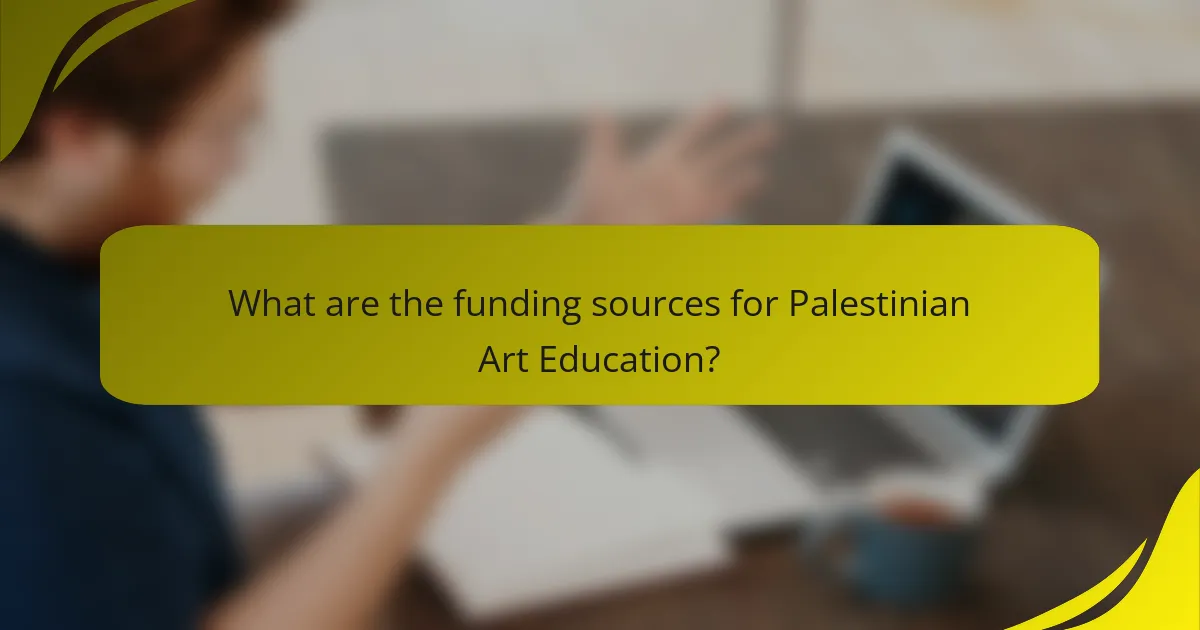
What are the funding sources for Palestinian Art Education?
Funding sources for Palestinian Art Education include governmental support, international NGOs, and private donations. Palestinian Authority provides some funding through cultural initiatives. International organizations, such as UNESCO, also contribute to art education programs. Grants from foreign governments support various cultural projects. Local and international NGOs often run art initiatives with specific funding. Community fundraising efforts supplement these sources. Partnerships with educational institutions help secure additional resources. These combined efforts aim to sustain and promote art education in Palestine.
How do governmental and non-governmental organizations contribute to funding?
Governmental and non-governmental organizations contribute to funding through grants, donations, and partnerships. Governments allocate budgets specifically for cultural and educational initiatives. For example, many countries provide financial support for art education programs. Non-governmental organizations often raise funds through private donations and fundraising events. They also apply for grants from international bodies. These contributions are vital for sustaining art education in Palestine. Studies show that funding from these organizations directly impacts program availability and quality.
What are the main governmental funding bodies for Palestinian Art Education?
The main governmental funding bodies for Palestinian Art Education include the Palestinian Ministry of Culture and the Palestinian Ministry of Education. These ministries provide financial support and resources for art programs in schools and cultural institutions. The Palestinian Authority allocates budgetary funds to promote arts and culture. International partnerships also enhance funding opportunities for Palestinian art education initiatives. These bodies aim to foster creativity and cultural expression among Palestinian youth.
How do international organizations support Palestinian Art Education financially?
International organizations support Palestinian art education financially through grants and funding initiatives. These organizations provide direct financial assistance to art programs and institutions in Palestine. For example, UNESCO has funded various art education projects aimed at fostering cultural expression among Palestinian youth. Additionally, the European Union allocates funds specifically for cultural and educational initiatives in Palestine. Various NGOs also contribute by sponsoring workshops and art exhibitions. These financial supports aim to enhance artistic skills and promote cultural heritage. Overall, international funding plays a crucial role in sustaining and developing art education in Palestine.
What alternative funding sources exist for Palestinian Art Education?
Alternative funding sources for Palestinian Art Education include international grants, crowdfunding platforms, and private sponsorships. Organizations such as the Arab Fund for Arts and Culture provide grants specifically for cultural initiatives. Crowdfunding platforms like GoFundMe allow individuals to support specific art projects directly. Additionally, private sponsorship from local businesses can help sustain art programs. These sources are vital due to limited governmental support for arts education in Palestine. Research indicates that diverse funding strategies enhance the sustainability of art education initiatives.
How do community initiatives contribute to funding?
Community initiatives contribute to funding by fostering local engagement and generating financial support. They often organize events that raise awareness and funds for specific projects. For instance, art exhibitions can attract donations from attendees. Additionally, initiatives can create partnerships with local businesses for sponsorship. This collaboration can lead to financial contributions and resource sharing. Grants can also be pursued by these initiatives, increasing funding opportunities. Research shows that community-driven projects often receive higher levels of local support. This support can be vital for sustaining art education programs in Palestinian communities.
What role do private donations play in supporting Palestinian Art Education?
Private donations are crucial for supporting Palestinian art education. They provide essential funding for art programs and initiatives. Many art institutions in Palestine rely on these contributions to sustain their operations. Donations help cover costs for materials, workshops, and exhibitions. They also enable scholarships for students pursuing art education. According to a report by the Palestinian Ministry of Culture, over 60% of art programs are funded through private donations. This highlights the significant impact of individual and corporate contributions on the arts in Palestine. Without these donations, many programs would struggle to survive.
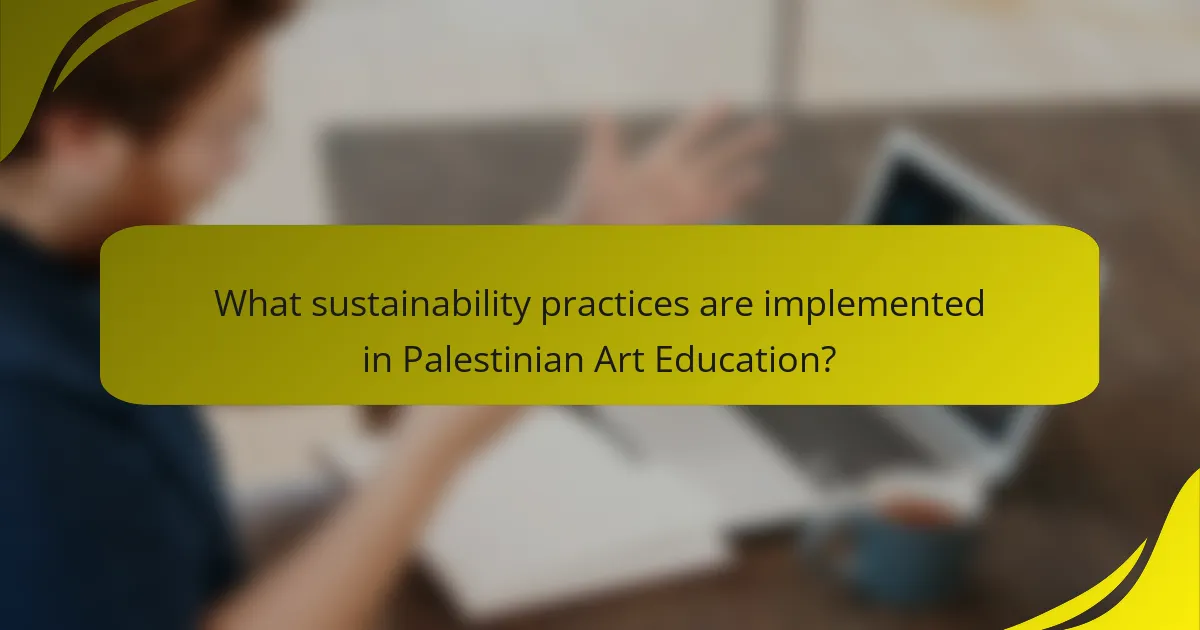
What sustainability practices are implemented in Palestinian Art Education?
Palestinian Art Education implements several sustainability practices. These practices include the use of recycled materials in art projects. Schools encourage students to create art using local and sustainable resources. Community involvement is emphasized to foster support for local artists. Workshops often focus on traditional techniques that promote cultural heritage. Collaborations with environmental organizations enhance awareness of ecological issues. Educational programs integrate sustainability themes into the curriculum. These practices aim to develop both artistic skills and environmental consciousness among students.
How can Palestinian Art Education adopt sustainable practices?
Palestinian Art Education can adopt sustainable practices by integrating eco-friendly materials and methods into the curriculum. This includes using recycled and natural materials for art projects. Educators can also incorporate lessons on environmental awareness and sustainability in art creation. Collaboration with local artisans can promote traditional techniques that are environmentally friendly. Establishing community gardens can provide resources for natural dyes and materials. Additionally, workshops on sustainable practices can enhance students’ understanding of environmental impact. Research indicates that art education can foster a sense of responsibility towards the environment. Implementing these strategies can lead to a more sustainable art education framework.
What are the best practices for resource management in Palestinian Art Education?
Best practices for resource management in Palestinian Art Education include establishing partnerships with local and international organizations. These partnerships can provide funding and resources essential for art programs. Implementing community engagement initiatives can enhance resource allocation by involving local artists and educators. Additionally, developing a transparent budgeting process ensures funds are used effectively. Training educators in grant writing can help secure additional financial support. Utilizing digital platforms for art education can reduce costs and expand reach. Regular evaluation of resource use allows for adjustments and improvements in program delivery. These practices collectively enhance the sustainability and impact of art education in Palestine.
How can environmental consciousness be integrated into the curriculum?
Environmental consciousness can be integrated into the curriculum by including sustainability topics across various subjects. Teachers can incorporate lessons on local environmental issues in art projects. This approach encourages students to explore eco-friendly materials and methods. Schools can also organize field trips to local natural sites to enhance experiential learning. Collaborative projects with environmental organizations can provide practical applications of classroom knowledge. Additionally, integrating environmental themes in literature and history can broaden students’ perspectives. Research shows that interdisciplinary approaches enhance student engagement and awareness. For instance, a study by the National Environmental Education Foundation highlights the benefits of integrating environmental education into core subjects.
What are the long-term benefits of sustainability in Palestinian Art Education?
Sustainability in Palestinian Art Education fosters cultural preservation and community engagement. It ensures that artistic practices are maintained over generations. This approach enhances the quality of education by integrating local traditions with contemporary art forms. Sustainable practices promote environmental awareness among students. They also encourage collaboration among artists, educators, and communities. This collaboration can lead to increased funding and resource allocation for art programs. Furthermore, sustainability helps in developing a resilient art sector that can adapt to socio-political challenges. Long-term, this creates a vibrant cultural landscape that supports both personal and collective identities.
How does sustainability enhance the quality of education in the arts?
Sustainability enhances the quality of education in the arts by integrating eco-friendly practices into curricula. This approach promotes awareness of environmental issues among students. It encourages creativity through the use of sustainable materials in art projects. Furthermore, sustainable practices can lead to cost savings for educational institutions. Schools can allocate these savings to improve resources and facilities. Research shows that students engaged in sustainability-focused education demonstrate higher levels of critical thinking. This engagement fosters a deeper understanding of the interconnectedness of art and the environment. Ultimately, sustainability enriches the educational experience in the arts, preparing students for future challenges.
What impact does sustainability have on community engagement and support?
Sustainability positively impacts community engagement and support. It fosters a sense of shared responsibility among community members. Engaging in sustainable practices encourages collaboration and collective action. This collaboration often leads to increased participation in local initiatives. Research shows that sustainable projects can enhance community trust and cohesion. For example, a study by the International Journal of Sustainability in Higher Education found that sustainability initiatives improve community involvement by up to 40%. Additionally, sustainable practices can attract funding and resources, further strengthening community support. Overall, sustainability acts as a catalyst for deeper community connections and active participation.
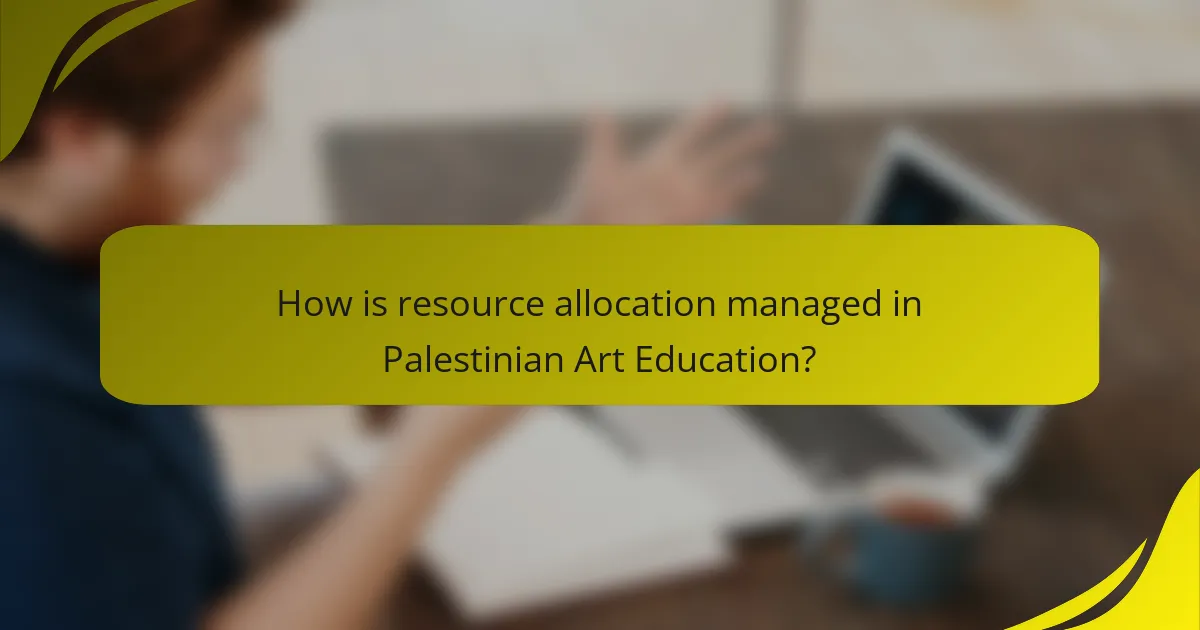
How is resource allocation managed in Palestinian Art Education?
Resource allocation in Palestinian Art Education is managed through a combination of governmental support, NGO funding, and community initiatives. The Palestinian Authority provides some funding for art programs, although it is often limited. Non-governmental organizations play a crucial role by offering financial resources and support for various art projects. Local communities also contribute by organizing fundraising events and workshops. Collaboration between these entities helps maximize available resources. Additionally, educational institutions prioritize art education in their curricula, ensuring that resources are allocated effectively. This multi-faceted approach aims to sustain and promote art education despite financial constraints.
What factors influence resource allocation in Palestinian Art Education?
Resource allocation in Palestinian Art Education is influenced by funding availability, political context, and community engagement. Funding availability determines the financial resources accessible for art programs. Political context affects the stability and support for educational initiatives. Community engagement plays a crucial role in mobilizing local support and resources. Additionally, cultural priorities influence the emphasis placed on art education within the curriculum. Economic conditions also impact the overall budget for educational institutions. These factors collectively shape how resources are distributed among art education programs.
How are resources prioritized in Palestinian art institutions?
Resources in Palestinian art institutions are prioritized based on cultural significance and community impact. Institutions often allocate funds to projects that promote local heritage and identity. They focus on initiatives that engage youth and foster artistic expression. Collaborative projects with international partners also receive attention to enhance visibility. Limited funding necessitates strategic decisions to maximize outreach and sustainability. Institutions assess community needs to guide resource distribution effectively. This prioritization reflects a commitment to cultural resilience amid socio-political challenges.
What role does community feedback play in resource allocation decisions?
Community feedback plays a critical role in resource allocation decisions. It helps identify the needs and priorities of the community. Engaging with community members ensures that resources are directed where they are most needed. Feedback can highlight gaps in existing services or programs. It also fosters transparency and accountability in decision-making processes. Research shows that participatory budgeting, which incorporates community input, leads to more equitable resource distribution. For instance, cities that implemented community feedback mechanisms reported improved satisfaction and better alignment of resources with community needs.
What are the best practices for effective resource allocation?
Effective resource allocation involves prioritizing resources based on strategic goals. Best practices include conducting a thorough needs assessment to identify gaps. This assessment should involve stakeholder input for comprehensive understanding. Setting clear objectives helps align resources with desired outcomes. Implementing a transparent budgeting process fosters accountability. Regular monitoring and evaluation of resource use ensures efficiency. Adjusting allocations based on performance data enhances effectiveness. Engaging in collaborative partnerships can leverage additional resources. Finally, fostering a culture of adaptability allows for quick responses to changing needs.
How can transparency improve resource allocation in Palestinian Art Education?
Transparency can improve resource allocation in Palestinian art education by ensuring accountability in funding distribution. Clear visibility of financial resources allows stakeholders to assess where funds are being allocated. This assessment can identify gaps in resource distribution, ensuring that critical areas receive necessary support. Transparency fosters trust among artists, educators, and donors. When stakeholders see how funds are utilized, they are more likely to contribute. Studies show that transparent systems lead to better decision-making and enhanced program effectiveness. For example, the World Bank highlights that transparency can reduce corruption, enabling more funds to reach intended educational programs. Thus, implementing transparency in financial practices can lead to more equitable and effective resource allocation in Palestinian art education.
What strategies can be employed to optimize limited resources?
Prioritizing resource allocation effectively optimizes limited resources. Implementing a needs assessment identifies critical areas for investment. Engaging stakeholders fosters collaboration and shared responsibility. Utilizing technology enhances efficiency and reduces costs. Establishing partnerships with local organizations maximizes resource sharing. Training staff in resource management improves overall utilization. Regularly reviewing and adjusting strategies ensures alignment with goals. These strategies are supported by successful case studies in resource optimization within educational contexts.
What practical steps can be taken to enhance Palestinian Art Education?
Enhancing Palestinian Art Education can be achieved through several practical steps. First, increasing funding for art programs is essential. This can be done by seeking grants from international organizations focused on education and culture. Second, establishing partnerships with local and global art institutions can provide resources and expertise. Third, integrating art education into the national curriculum will ensure its importance and accessibility. Fourth, providing training for teachers in contemporary art practices can improve instructional quality. Fifth, creating community art projects can engage students and foster local talent. Lastly, utilizing digital platforms for art education can expand reach and accessibility. Each of these steps addresses specific needs within Palestinian Art Education, contributing to its overall enhancement.
Palestinian Art Education is a system focused on teaching visual arts within the Palestinian territories, aiming to develop artistic skills and cultural awareness among students. The article explores various aspects, including funding sources such as governmental support, international NGOs, and private donations, as well as sustainability practices that incorporate eco-friendly methods and community engagement. It also examines resource allocation, highlighting the influence of political context and community feedback on the distribution of resources. Additionally, the article addresses challenges faced by art education in Palestine, such as limited funding and political instability, while proposing practical steps to enhance the quality and accessibility of art education.
